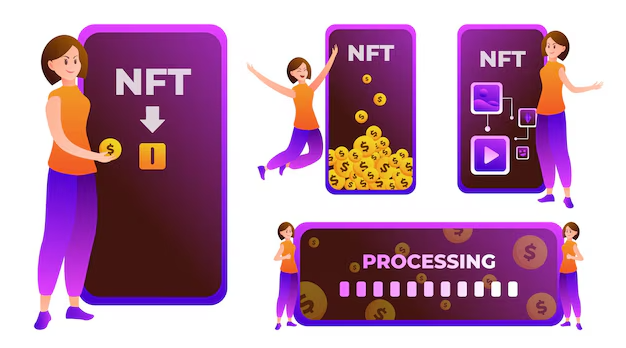Everything you need to know about NFT lending has been covered by us, including varieties of NFT lending, how NFT lending operates, and the advantages of NFT lending. The dangers associated with NFT loans in this thorough guide.
An Explanation of NFT Lending
NFT holders are able to borrow money against their assets through NFT lending. It has become more and more well-liked as a means for investors to obtain loans and release money.
Nonfungible tokens (NFTs) have several uses: they can be stored, exchanged, purchased, and sold. They are also a component of other DeFi arrangements, such as NFT loans. The difficulty in using NFTs in other DeFi industries is partly due to their nonfungible, or unique, nature, which has increased demand for NFT loans. For example, investors cannot yield or stake farm NFTs in the same manner as they can with fungible cryptocurrencies.
When comparing the NFT market to cryptocurrencies like Bitcoin (BTC), there is less liquidity. This is due to the fact that NFTs might be entirely unique and that finding a buyer for an NFT can be a time-consuming process for an owner.
Owners of NFTs can access financing, diversify their holdings, and release liquidity with NFT loans. NFT loans do, however, also come with risks due to other reasons like regulatory uncertainty and pricing volatility.
Different Forms of NFT Lending
Mutual-to-peer NFT Financing
Peer-to-peer NFT lending involves NFT owners listing their NFTs on a platform as collateral in order to get loan offers from other users.
Lending Using Peer-to-protocol NFT
This is the direct lending of NFT from a DeFi platform or protocol. By entangling NFTs in smart contracts within a protocol, borrowers collateralize their investment.
Non-transferable Debt Position
This approach involves a platform or provider providing a nonfungible debt position (NFDP) as a transparent record of a loan arrangement creating a unique asset on the blockchain. Similar to how users can collateralize Ether (ETH) for the stablecoin Dai (DAI) using MakerDAO’s collateralized debt position (CDP), an NFDP can likewise be traded.
NFT Leases
To access the perks or benefits provided by the NFT, NFT assets are moved from one user’s wallet to another through an NFT rental platform for the duration of a “tenancy.”
The Operation of NFT lending
Peer-to-peer NFT or peer-to-protocol lending is made possible by DeFi systems. As security for loans, NFT owners lock up their assets in smart contracts.
Owners utilize an NFT marketplace or NFT lending platform to post NFTs as collateral and get loan offers from lenders in order to access peer-to-peer NFT financing. The platform might offer market data or valuation tools to assist in figuring out the NFT’s fair worth. The owner of the NFT can select an offer they want, accept it, and then get the loan in their wallet—typically in the form of a stablecoin.
For the term of the loan, the platform will place the NFT in an escrow smart contract. The NFT is repaid if the borrower pays off the loan balance and interest before the loan term ends. Usually, the marketplace will impose a fee determined on the loan’s principal amount. The NFT, which is typically worth more than the loan value, is given to the lender in the event that the borrower defaults on the loan. In addition, the lender has the option to retain the NFT or liquidate it to cover their losses.
Lending via peer-to-protocol operates quite differently. The NFT owner takes out a direct loan from the lending protocol by depositing the NFT as collateral, which is subsequently secured by smart contracts within the protocol. In order to make cryptocurrency money available to borrowers, NFT lending platforms work with liquidity providers who add cryptocurrencies to the lending protocol pool.
How Nft Lending and Fractionalization Assist Investors in Releasing Liquidity
Fractionalization of NFTs can enable owners to mint tokenized fractional NFTs to unleash liquidity and increase the accessibility of high-value NFTs to additional investors.
Since NFTs are not fungible, they are often indivisible. They must be purchased or sold in their entirety. As opposed to this, fungible cryptocurrencies, such as Bitcoin (BTC), are divisible and allow investors to possess fractions of the cryptocurrency, known as satoshis.
NFT fractionalization is now offered in the NFT lending arena. Smaller, fungible tokens that reflect a portion of the original NFT’s ownership are used to represent fractionalized NFTs. Tokenized fractional NFTs are another means for owners of nonfungible tokens, especially those with high-value NFTs, to unlock liquidity in their tokens. It makes high-value NFT investments more accessible to investors who cannot afford the entire NFT and gives investors access to these assets and their value.
The goal of both fractionalization and NFT lending is to make NFTs more liquid. Moreover, NFT fractionalization broadens the pool of potential investors for NFT lending and may even inspire owners to employ hybrid lending and fractionalization tactics in order to extract value from their NFTs.
If an NFT owner needs immediate cash, they can sell the shares they’ve fractionalized. The remaining, unfractionalized portion of the NFT can subsequently be used as collateral to get a loan in the NFT lending market. With this approach, owners can access more capital than they could through lending or fractionalization alone.
NFT Lending Advantages
NFT lending enables borrowing without credit checks, unlocking NFT liquidity for owners and creators of digital art.
Real estate and other tokenized assets, as well as digital art and collectibles, can all be represented by NFTs. Although NFTs have varying values, certain collections feature NFTs that fetch astronomically high prices. But there are a lot of other NFTs with far lower values.
Getting Capital and Liquidity
Without having to sell NFTs from their collections, owners can access or unlock money through NFT lending. This option is available to investors who wish to swiftly release funds for the acquisition of other assets or for other uses.
Digital art and DeFi
Digital artwork In the crypto world, NFTs have shown to be popular. NFT lending offers a bridge between digital art and DeFi. Artists and collectors with a sense of purpose can make the most of the area.
No Credit Inquiries
Similar to other DeFi loans, NFT loans do not require the credit checks that are necessary for traditional financing. Loans are available through the cryptocurrency market to borrowers with bad or low credit scores. NFT lending platforms may, however, conduct standard Know Your Customer (KYC) checks in order to abide by laws and lower the possibility of fraud.
The Dangers Associated with NFT Loans
The market is impacted by regulatory uncertainty, smart contracts are susceptible to attacks, and NFT volatility increases risk.
NFT lending has unique risks in addition to the usual dangers connected with cryptocurrency.
Unpredictability
NFTs’ value fluctuates, much like that of cryptocurrencies. This makes valuing an NFT to secure a loan more difficult. A liquidation scenario may occur if the NFT value is less than the loan value, in which case the borrower defaults on the debt and the lender receives the NFT.
Availability of Liquid Assets
Because it enables NFT holders to access liquidity in situations where NFTs are challenging to sell, NFT lending may be appealing. But because NFTs are not as liquid as other securities, in the event of a loan default, both the lender and the new owner might find it difficult to sell the NFT in order to get their money back.
Intelligent Contracts
Smart contracts lock down collateralized NFTs and loan terms, but there’s always a chance that faults or attacks might cause NFTs or money to disappear.
Control
NFT lending is subject to the same regulatory uncertainties that surrounds cryptocurrencies and the DeFi industry. The market and the sustainability of NFT loans are greatly impacted by changes in regulatory risk, and these changes may also necessitate that stakeholders modify or follow compliance standards.
The low liquidity problem for NFTs can be resolved by NFT lending, which enables owners to utilize their assets rather than only keeping them to grow in value. However, there are still other disadvantages. NFT minting can use a lot of energy, and Ethereum gas fees for transaction validation can be expensive.













Leave a Reply